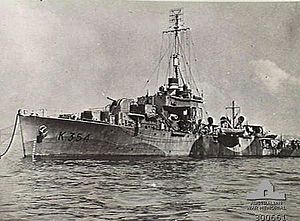 Gascoyne c. 1943 Gascoyne c. 1943
| |
| History | |
|---|---|
| Name | Gascoyne |
| Namesake | Gascoyne River |
| Builder | Mort's Dock & Engineering Company, Sydney |
| Laid down | 3 July 1942 |
| Launched | 20 February 1943 |
| Commissioned | 18 November 1943 |
| Decommissioned | 12 April 1946 |
| Recommissioned | 8 June 1959 |
| Decommissioned | 1 February 1966 |
| Reclassified | Oceanographic Research Ship |
| Motto | "Return to the Sea" |
| Honours and awards |
|
| Fate | Sold for scrap in 1972 |
| Badge |  |
| General characteristics | |
| Class and type | River-class frigate |
| Displacement | 1,489 tons (standard), 2,120 tons (full load) |
| Length | 301 ft 6 in (91.90 m) |
| Beam | 36 ft 7.75 in (11.1697 m) |
| Draught | 12 ft (3.7 m) |
| Propulsion | Triple expansion, 2 shafts. 5,500 horsepower (4,100 kW) |
| Speed | 20 knots (37 km/h; 23 mph) |
| Complement | 140 |
| Armament | |
HMAS Gascoyne (K354/F354/A276) was a River-class frigate that served in the Royal Australian Navy (RAN). Laid down in 1942 and commissioned in 1943, the frigate served during World War II, before being placed in reserve in 1946. Reactivated in 1959, Gascoyne was reclassified as a survey and research ship, a role she fulfilled until she was decommissioned again in 1966, and sold for scrap in 1972.
Construction
Gascoyne was laid down by Mort's Dock & Engineering Company, Sydney on 3 July 1942. She was launched on 20 February 1943 by Lady Wakehurst, wife of the Governor of New South Wales, and commissioned into the RAN on 18 November 1943. The ship was named after the Gascoyne River.
Operational history
Gascoyne was present in Tokyo Bay on Victory over Japan Day (2 September 1945), when the Japanese Instrument of Surrender was signed.
The frigate received five battle honours for her wartime service: "New Guinea 1944", "Leyte Gulf 1944", "Lingayen Gulf 1945", "Borneo 1945", and "Pacific 1945".
Gascoyne paid off into reserve on 12 April 1946, but recommissioned at Sydney on 8 June 1959 for survey and oceanographic research duty. She was equipped with a deep water mechanical bathythermograph instrument.
Decommissioning and fate
Gascoyne paid off again on 1 February 1966, and was sold for scrap to the Fujita Salvage Company Limited of Osaka in Japan on 15 February 1972. The bathythermograph was transferred to HMAS Sprightly. Gascoyne left Melbourne under tow for Japan on 6 July 1972.
References
- "Allied Ships Present in Tokyo Bay During the Surrender Ceremony, 2 September 1945". Naval Historical Center - U.S. Navy. 27 May 2005. Retrieved 13 January 2007.
Taken from Commander in Chief, U.S. Pacific Fleet and Pacific Ocean Areas (CINCPAC/CINCPOA) A16-3/FF12 Serial 0395, 11 February 1946: Report of Surrender and Occupation of Japan
- "Navy Marks 109th Birthday With Historic Changes To Battle Honours". Royal Australian Navy. 1 March 2010. Archived from the original on 13 June 2011. Retrieved 23 December 2012.
- "Royal Australian Navy Ship/Unit Battle Honours" (PDF). Royal Australian Navy. 1 March 2010. Archived from the original (PDF) on 14 June 2011. Retrieved 23 December 2012.
This article about a specific Australian naval ship or boat is a stub. You can help Misplaced Pages by expanding it. |